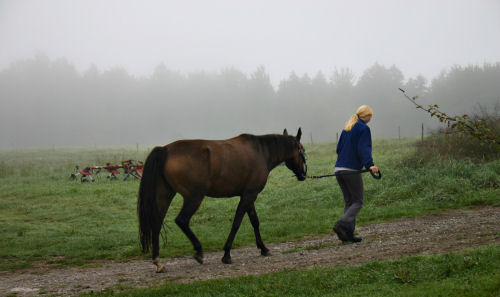A 365-Day Project
"We Are All Mozart"
A project to create
new works and change
the perception of the
music of our time.


 September 11, 2006
September 11, 2006 
It has been an interesting week.
The creative forces push us forward in different ways. For me, creating in one genre doesn't preclude creativity in another. But the same genre creates a deep conflict, a crossing of internal messages. Failure is inevitable.
So this week demanded that five technical articles about real-time location systems be written and a presentation about We Are All Mozart be presented. The past seven days also carried me into an interesting Wikipedia experience and, of course, thoughts about September 11, 2001.
The last first. I have nothing profound to say about the events of five years ago, only to remember that we had just finished the Ought-One Festival of NonPop and were still feeling elated two weeks later, preparing an enthusiastic email that very morning. And just hours later that elation had collapsed. Struggling to find anything at all to do that would have meaning, we created an open invitation on Kalvos & Damian to submit compositions written in reflection of the day's events. The Musical Gallery remains intact with more than sixty compositions, and provides a gut sense of how we felt.
Getting Marked
For those outside the field, the term "automatic identification and data capture" (AIDC) may have no importance and even no meaning whatsoever. For those who do know about AIDC, it is a polarizing technology, heavily political in nature.
AIDC plays a significant if largely anonymous role in contemporary life. The uniform product codes (UPC) on a can of peaches or the back of a CD are automatic identification markings. So is the little target-like square pattern on a UPS package, or the lines printed at the bottom of an envelope in your mailbox. The silver patterned squares on product cartons, the long anonymous plastic rectangles on vitamin bottles, and the big squares tied around expensive products at Staples -- all are part of AIDC. Your credit card uses it along with the mechanical telephone operator that asks you to speak the card number aloud. Your computer scanner uses AIDC to convert scans to text, as do telephone cards in telling you how many minutes you have left. Your passport will have it next year, too, and if you bought a new laptop recently it probably has a touch pad that knows who you are. Cows and horses are marked with AIDC. Certainly anyone working in a government installation knows that their access depends on it. Got a Mobil Speedpass? Easy pass at a tollbooth? AIDC both. Nuclear missiles instructions were barcoded on temperature-stabilized ceramic plates (sure, you needed to know that).
Auto ID began life in coding inventions that could clarify details and improve a person's accuracy in performing mundane activities, such as Morse code or resistor color bands based on the rainbow. Some folks are old enough to remember the long-abandoned automatic car identification (ACI) color bands on railroad cars that helped reshuffle them to their destinations as they passed by at up to 80 mph.
And that's where it really began to make sense -- as an automated way to take inventory, track goods, and replenish shelves. David Gunn and I have worked together for a long time, and it's funny to remember where our paths have crossed. For example, we both worked as Radio Shack clerks in the same store. We dreaded inventory days, a weekend during which every item in the store was handled, its catalog number and quantity read aloud, and the results marked down and tallied to find out how well the store was growing -- or in our shoddy corner of the community, its level of theft, benignly called "shrinkage." In a few years, the highly reliable UPC had ended those hand inventories (too late for us, though).
It wasn't long before the nascent automatic identification field found applications wherever high speed and accuracy were considered important. The codes were fast because computers calculated faster than people could read and write. And they were reliable because computers could read the thickness of dark bars and light spaces and check the number for accuracy against itself -- a checksum method, much like the one that later would automatically correct the digital information streaming off the surface of scratched CDs and today does the same for the data on this page reaching you from the internet.
In the rush to capitalibanize the world, barcodes made international trade efficient, reduced time to market, and pushed companies into a tightening spiral of competitive pricing and timing. Wal-Mart would not exist without the barcode. Auto ID expanded. Simple barcodes contained some information, and two-dimensional barcodes (the "target" shaped squares on that FedEx package) contained more. The magnetic strips on credit cards were like a miniature tape recording. They could not only hold a lot of info, but they could be written to -- re-recorded on the fly. But barcodes and credit cards required either a line of sight or contact reading. Companies wanted more, more, faster.
The most dramatic -- and for some, most ominous -- change came with the development of radio-frequency identification (RFID). Like barcodes, RFID uses a reader and a tag, but very small radios (similar to the radios found in cell phones) made this identification technique practical. And since radio signals pass through objects, the technology was ideal for identifying, say, boxes stacked inside pallets, equipment lost in a building, or cattle grazing on the upper forty.
Active RFID uses a battery-powered tag so it can answer a request made by the reader, send information to the reader, and store new information. Long-lived batteries make active RFID fairly bulky, but active tags also contain massive amounts of information, have a long range, and are able to be re-used.
Passive RFID uses a tiny permanent memory chip and a foil antenna. The chip is actually powered by the radio waves sent from the reader, and responds with its embedded data. The passive tags have a very short range (from an inch to a few feet). Passive tags will be used in passports over the next few years, but not everyone is cheering for "spychips" in any form, especially those placed surreptitiously or embedded in people (voluntarily or not).
The application that called on my writing skills (and short-circuited my ability to write these daily commentaries) was the use of AIDC in healthcare. (It seems to have become one word now.)
The regulatory requirements in U.S. healthcare have become toxic, and hospitals are searching for ways to spend more time on patient care -- or, depending on whose voice you're hearing, to reduce liability and increase profits by using automated documentation. In either case, healthcare is monstrously murky. Equipment gets lost or stolen. Doctors make dangerous mistakes. Nurses are swamped in paperwork. Tools get left inside patients. Counterfeit and expired drugs appear. Patient care suffers.
The federal government has already begun feasibility studies using RFID, on the surface a consumer protection measure. Private companies have also developed RFID systems to prevent loss or theft of equipment, locate carts or monitors in emergencies, and assure patients are matched with their medical needs. In the best possible world, auto ID would release doctors and nurses from paperwork altogether -- if companies are held to a high level of integrity.
My wife Stevie, a long-time healthcare professional, thinks it's more about reducing liability, removing responsibility, and making people stupid, denying their professional and experiential knowledge. It's tough being a tech writer around a committed and honest humanist.
I sure do prefer composing.
Upcoming
Tomorrow: My WAAM presentation to the National Extension Tourism Conference.
Wednesday: An interesting nonpop experience with the Wikipedia power structure.

After a ride, Lila walks her horse Haley from the barn to the foggy pasture early on Friday morning.